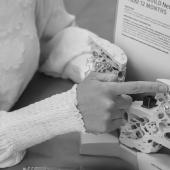Pain Reliever
“I could hardly snap my fingers with my right hand. Everything I tried seemed to make it worse. It got to be, some days, that all I could focus on was the pain.” That is how David Chavez, a Colorado Springs native, described the life-altering medical issues he’d been dealing with for months.
The pain itself began in his neck, and he’d manage it with visits to the chiropractor, massages, and daily doses of pain relievers like Acetaminophen and Ibuprofen. But soon the pain traveled down to his right shoulder and arm, eventually leading to numbness and tingling in his fingers. Concerned about long-term damage, David Chavez finally decided to see Dr. Roger Sung, a practitioner at Colorado Springs Orthopaedic Group, who, after trying conservative methods, performed an artificial disc replacement surgery that David says not only provided immediate relief of his symptoms, but left him feeling better than he had in years.

When asked just how long the pain he was feeling had been going on, he couldn’t put an exact date on it, just, “It’d been going on for years.” David is not alone. According to the U.S. Pain Foundation, over 50 million Americans live with chronic pain. Like most of them, David simply did his best to manage it. But then, in December of 2022, things took a drastic turn.
“I couldn’t manage it anymore,” David said. “It just wouldn’t go away. I had severe pain, loss of strength in my right arm, numbness, tingling, and stabbing pains. I mean, you name it.” All of the things that had worked in the past now seemed to make his symptoms worse. “I could still do most everything that I normally do, but the loss of strength was pretty noticeable. And the pain. If I was going to put a number to it, on a scale of 10, I’d say it was an 8 or 9.”
David continued to try to manage the pain but when he was unable to find relief he began to worry about long-term damage. He and his wife, Annie, enjoy a very active lifestyle. They’ve done everything from riding motorcycles and scuba diving to going on trips in their travel trailer and visiting their grandchildren. The thought of permanent, life-altering damage was enough to prompt David to finally say to Annie, “I need to go see someone about this.” He consulted Dr. Sung, a fellowship trained and board certified orthopedic surgeon who specializes in cervical and lumbar surgery, microsurgery, and minimally invasive surgery at Colorado Springs Orthopaedic Group.
When David saw Dr. Sung, the first thing they did was get X-rays and an MRI to identify the source of the problem. “We always want to know what it is that’s really bothering [the patients] and then, we want to make sure that what we see and what we’re recommending, whether surgical or non-surgical, is actually addressing what their complaints are,” said Dr. Sung. In David’s case, the damage was due to wear and tear. Two of the discs in his cervical spine (or neck, as it’s more commonly known) had thinned and there was some arthritis, but no herniation (swelling) or degeneration. The condition of his spine made David a good candidate for disc replacement surgery, but he and Dr. Sung decided to take a more conservative approach first.

David completed 6 weeks of physical therapy, received an injection, and took oral steroids before discussing surgery with Dr. Sung. “For the right patient with the right problems, sometimes there are multiple options,” says Dr. Sung. “Many patients have problems that get better with conservative measures. Because of this, we consider surgery for patients who did not get better with conservative treatments.”
Dr. Sung went on to explain that it is absolutely possible to manage chronic pain conservatively but that, in his opinion, if a patient has reached a point where the pain and symptoms they feel are affecting their day-to-day decisions around things like going to work or going to have fun, it is time to do something about it as untreated back or neck pain can result in nerve damage, further injury, or disability. “The idea of living the rest of your life like that and hoping the pain will eventually go away is not very real at that point,” Dr. Sung says.
When patients like David get to the point of surgery, the goal is to provide relief from pain, numbness, tingling, or weakness that goes down their extremities. The way to provide that relief, states Dr. Sung, is to “make space for the nerves and provide something to replace what is removed.” The two options are fusion or disc replacement. Fusion involves putting in “a construct that doesn’t move, holds the discs open, holds space for the nerves, and works really well,” says Dr. Sung. This option can limit mobility, which David wanted to avoid. He did some research, consulted with Dr. Sung, and eventually decided that disc replacement surgery was a better fit for him. Disc replacement involves putting in a device that still moves, doesn’t restrict motion, and, more importantly, puts less stress on the other discs so that, in theory, they will wear slower.
It’s important to note that not every patient is a good candidate for disc replacement surgery, as it’s better suited for patients who do not have severe degeneration or instability in their spine. In addition, disc replacement surgery in the neck is only FDA-approved for the replacement of two discs. Anything beyond that would not be allowable in the U.S.
David prepared for a minimum of 8 weeks of recovery time, during which he would be at home with Annie, who is retired. “I was afraid we were going to get sick of each other!” David says with a laugh. Thankfully, the recovery went very smoothly and, when it was time for David to return to work, Annie said, “You know, I’m going to miss you being home every day.”
Now, almost a year after surgery, David sits in his home in Colorado Springs, all smiles as he describes his current health. “Not everyone is 100% after neck surgery, but I am 100%.” When asked how soon he was able to feel relief after surgery, his response was quick and enthusiastic. “It was immediate.”
Dr. Sung says that while not every patient can resolve all of their symptoms, even with surgery, the immediate relief that David experienced is common. “Once you relieve that pressure on the nerve, the pain relief is pretty quick.” David adds “…it worked for me, and I think I made the right decisions through the whole thing. I wouldn’t have asked for better results.”
Ultimately, the decision of whether or not to have spinal surgery is unique to each person. As Dr. Sung puts it, “You can read all you want online, and you’ll get a lot of information, but the hardest part is putting it all together to recognize what’s the right decision for you as an individual.” For patients who have reached a point where their pain is affecting their day-to-day decisions, or if the pain started suddenly and severely, Dr. Sung recommends getting an evaluation. “Let us give you our best opinion as to whether or not surgery is what you need at all or if we should continue conservative treatment.”





